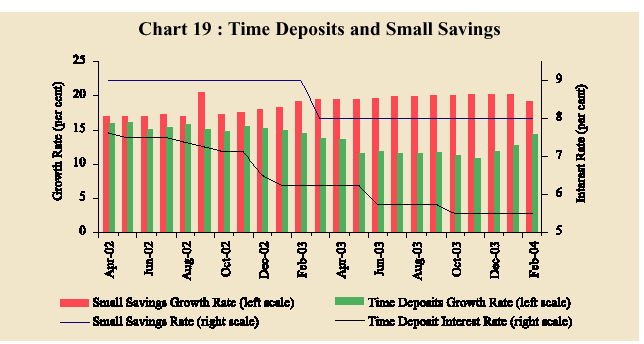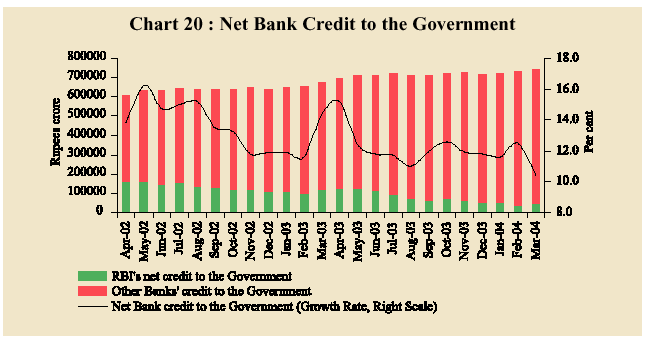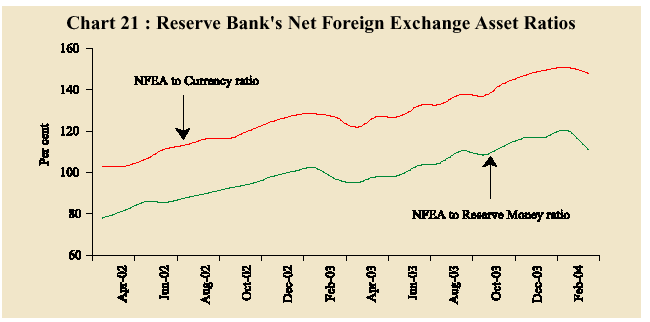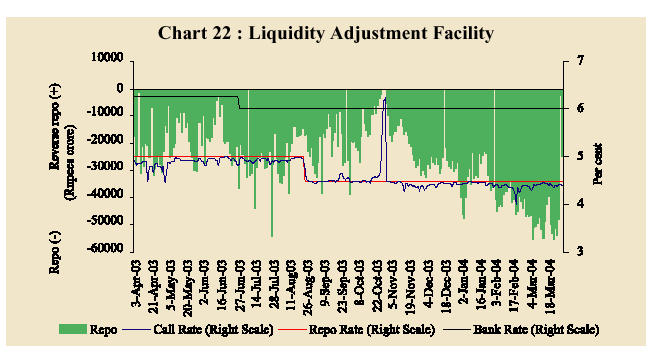III. Monetary and Liquidity Conditions - RBI - Reserve Bank of India
III. Monetary and Liquidity Conditions
Monetary Trends
Credit Behaviour
Reserve Money
Liquidity Adjustment Facility
Monetary conditions continued to ease during 2003-04. Reserve money expansion was higher than in 2002-03 even though large and persistent capital inflows were substantially sterilised by outright open market operations (OMOs) and repos under the Liquidity Adjustment Facility (LAF). Overall monetary expansion was also higher than in the preceding year, albeit in consonance with higher output growth. Money supply accelerated to 15.3 per cent as on April 16, 2004 from 13.3 per cent as on April 18, 2003. In terms of the residency-based broad money (NM3),which, inter alia, excludes the impact of the redemption of Resurgent India Bonds (RIBs) during the year, monetary expansion was even higher. Non-food credit started picking up from August 2003 onwards with the firming up of industrial activity and consumer demand. Liquidity in the financial system continued to be ample, even as substitution occurred between time deposits in the banking system and small savings. As a consequence, the liquidity aggregates(L1,L2,L3) recorded a higher order of expansion in 2003-04 (Table 10).
Table 10 : Monetary Indicators
| (Amount in Rupees crore) |
|||||||
|
|
|||||||
| Item |
Outstanding |
Variation |
|||||
| as on March |
2002-03 |
2003-04 |
|||||
| 31, 2004 |
Absolute |
Per cent |
Absolute |
Per cent |
|||
| 1 |
2 |
3 |
4 |
5 |
6 |
||
|
|
|||||||
| I. |
Reserve Money |
4,36,429 |
31,091 |
9.2 |
67,368 |
18.3 |
|
| II. |
20,00,349 |
1,91,177 |
12.8 |
2,81,147 |
16.4 |
||
| Broad Money (M3) |
|||||||
| a. |
Currency with the Public |
3,16,758 |
30,587 |
12.7 |
45,376 |
16.7 |
|
| b. |
Aggregate Deposits |
16,78,550 |
1,60,197 |
12.8 |
2,33,972 |
16.2 |
|
| i. Demand Deposits |
2,51,371 |
18,591 |
10.4 |
53,581 |
27.1 |
||
| ii. Time Deposits |
14,27,179 |
1,41,606 |
13.2 |
1,80,391 |
14.5 |
||
| Of which: Non-Resident Foreign |
|||||||
| Currency Deposits |
75,419 |
1,421 |
1.6 |
-16,852 @ |
-18.3 @ |
||
| III. |
NM |
3 |
19,53,960 |
1,95,951 |
13.8 |
3,08,498 |
18.7 |
| IV. |
a. |
L1 | 20,23,153 |
2,07,300 |
14.2 |
3,22,416 |
19.0 |
| Of which :Postal Deposits |
69,193 |
11,349 |
25.8 |
13,918 |
25.2 |
||
| b. |
L2 | 20,29,665 |
2,08,455 |
14.2 |
3,22,632 |
18.9 |
|
| Of which :FI Deposits |
6,512 |
1,155 |
22.5 |
216 |
3.4 |
||
| c. |
L3 | 20,49,966 |
2,08,604 |
14.0 |
3,23,359 |
18.7 |
|
| Of which :NBFC Deposits |
20,301 |
148 |
0.8 |
727 |
3.7 |
||
| V. |
Major Sources of Broad Money |
||||||
| a. |
Net Bank Credit to the Government (i+ii) |
7,44,616 |
84,865 |
14.4 |
70,186 |
10.4 |
|
| i. Net Reserve Bank Credit to Government |
47,555 |
-31,499 |
-20.7 |
-73,125 |
-60.6 |
||
| Of which :Centre |
43,806 |
-28,399 |
-20.1 |
-69,179 |
-61.2 |
||
| ii. Other Banks’ Credit to Government |
6,97,061 |
1,16,364 |
26.6 |
1,43,310 |
25.9 |
||
| b. |
Bank Credit to Commercial Sector |
10,11,074 |
87,897 |
11.6 |
1,18,986 |
13.3 |
|
| Of which :Scheduled Commercial Banks’ |
|||||||
| Non-food Credit |
7,99,420 |
99,448 |
18.6 |
1,19,684 |
17.6 |
||
| c. |
Net Foreign Exchange Assets of the |
||||||
| Banking Sector |
5,15,304 |
82,680 |
26.6 |
1,21,589 |
30.9 |
||
|
|
|||||||
| Data are provisional. |
|||||||
Currency demand accelerated in 2003-04 reflecting the strong recovery in agricultural performance. The growth of banks’ time deposits, though higher than in 2002-03, was compressed by the bullet redemption of RIBs in October 2003. Postal deposits recorded substantially higher expansion than time deposits as bank deposit rates were moderated during the year while interest rates and fiscal concessions on small savings remained unchanged (Chart 19).

Credit Behaviour
Non-food credit demand shrugged off an initial sluggishness and recorded an upsurge from mid-August 2003. Housing credit continued to be an important driver of credit growth, benefiting from tax incentives and lower interest rates. Retail credit was also strong, buoyed by reviving consumer demand. Credit to industry also picked up in the latter half of the year. During the year, there was increased recourse by corporates to internal sources of financing as well as to external commercial borrowings (ECBs) (Table 11). Food credit experienced a contraction on account of a steady decline in food stocks.
Table 11 : Key Sources of Funds to Industry
| (Rupees crore) |
|||
|
|
|||
| Component |
2002-03 |
2003-04 |
|
| 1 |
2 |
3 |
|
|
|
|||
| 1. |
Bank Credit to Industry # |
24,189 |
10,307 |
| 2. |
External Commercial Borrowings (including short-term trade credits) # # |
-8,007 |
16,646 |
| 3. |
Net Profits @ |
9,445 |
14,086 |
| 4. |
Depreciation Provision @ |
8,860 |
9,525 |
|
|
|||
| # Data relate to April-February and are inclusive of small-scale industries. |
|||
The growth of net bank credit to the Government, at 10.4 per cent during 2003-04, was the lowest since 1994-95. A number of factors such as disinvestment proceeds, receipts under the Debt Swap Scheme, higher revenue buoyancy and higher mobilisation on account of Savings Bonds enabled a build-up of cash balances of the Central Government, which contributed to neutralising liquidity. Commercial banks’ holdings of statutory liquidity ratio (SLR) securities, at 41.5 per cent of their net demand and time liabilities (NDTL) as at end-March 2004, remained far in excess of the statutory requirement (Chart 20).

Reserve Money
Reserve money was driven up by a record accretion to the net foreign exchange assets (NFEA) of the Reserve Bank during 2003-04 (Table 12). The expansion in the RBI’s NFEA in the first quarter (ending June 2003) was largely unsterilised although the Centre’s market borrowing programme was the heaviest in the quarter. Reserve money declined in the second quarter with the demand for currency exhibiting the usual seasonal contraction. A reduction in bankers’ deposits with the Reserve Bank also occurred on account of a 25 basis point cut in the cash reserve ratio (CRR), effective June 14, 2003. With the relentless expansion in NFEA in the second quarter, sterilisation operations were undertaken in the form of open markets sales (Rs.16,671 crore) and primary auctions of the Centre’s dated securities which pushed up the Centre’s cash balances by Rs.24,395 crore. The Reserve Bank's NFEA accretion continued in the third quarter notwithstanding sales on account of the RIB redemptions and pre-payments of external debt. Sterilisation operations were stepped up (net OMO sales of Rs.14,225 crore and LAF repos of Rs.3,580 crore) but were lower than the expansionary effect of the massive NFEA accretion on reserve money.
This was also coincident with a pick-up in currency demand. Reserve money expansion continued in the fourth quarter with NFEA accretion unabated and accompanied by a further pick-up in currency demand. Sterilisation operations in the fourth quarter were through LAF repos (Rs.5,155 crore) and OMO sales (Rs. 5,332 crore). Reserve money expansion during the year was amplified also by a build up of bank reserves of Rs.19,662 crore during March 26-31, 2004, reflecting year-end considerations. The increase in reserve money has continued to remain higher at 12.7 per cent, on a year-on-year basis on April 30, 2004, than 11.6 per cent a year ago.
Table 12 : Reserve Money
| (Rupees crore) |
|||||||||||
|
|
|||||||||||
| Item |
2002-03 |
2003-04 |
2002-03 |
2003-04 |
|||||||
| Q1 |
Q2 |
Q3 |
Q4 |
Q1 |
Q2 |
Q3 |
Q4 |
||||
| 1 |
2 |
3 |
4 |
5 |
6 |
7 |
8 |
9 |
10 |
11 |
|
|
|
|||||||||||
| Reserve Money |
31,091 |
67,368 |
-8,850 |
6,791 |
7,917 |
25,233 |
16,342 |
-18,239 |
23,983 |
45,282 |
|
| (9.2) |
(18.3) |
||||||||||
| Components |
|||||||||||
| 1. |
Currency in circulation |
31,499 |
44,550 |
14,633 |
-5,901 |
11,205 |
11,561 |
17,882 |
-5,955 |
17,986 |
14,636 |
| (12.6) |
(15.8) |
||||||||||
| 2. |
Bankers’ Deposits |
||||||||||
| with the RBI |
-801 |
21,019 |
-23,873 |
12,451 |
-2,427 |
13,048 |
-1,606 |
-12,633 |
5,961 |
29,297 |
|
| 3. |
‘Other’ Deposits |
||||||||||
| with the RBI |
393 |
1,799 |
389 |
241 |
-861 |
625 |
65 |
349 |
36 |
1,349 |
|
| Sources |
|||||||||||
| 1. |
RBI’s net credit to |
||||||||||
| Government |
-31,499 |
-73,125 |
-4,212 |
-19,779 |
-17,427 |
9,919 |
-4,451 |
-53,146 |
-12,506 |
-3,021 |
|
| Of which : to Centre |
-28,399 |
-69,179 |
1,455 |
-19,555 |
-17,882 |
7,583 |
434 |
-53,744 |
-15,844 |
-25 |
|
| (-20.1 ) |
(-61.2) |
||||||||||
| 2. |
RBI’s credit to Banks |
||||||||||
| and Commercial Sector |
-6,468 |
-2,728 |
-6,537 |
-784 |
8 |
844 |
-1,564 |
-2,525 |
-796 |
2,156 |
|
| 3. |
NFEA of the RBI |
94,275 |
1,26,169 |
19,279 |
19,619 |
34,766 |
20,611 |
22,710 |
25,720 |
51,931 |
25,808 |
| (35.7) |
(35.2) |
||||||||||
| 4. Government’s Currency |
|||||||||||
| Liabilities to the Public |
705 |
220 |
168 |
256 |
157 |
124 |
84 |
74 |
43 |
19 |
|
| 5. |
Net Non-Monetary |
||||||||||
| Liabilities of RBI |
25,922 |
-16,831 |
17,548 |
-7,479 |
9,587 |
6,265 |
437 |
-11,639 |
14,689 |
-20,319 |
|
| Memo: |
|||||||||||
| 1. |
Net Domestic Assets |
-63,184 |
-58,801 |
-28,130 |
-12,829 |
-26,849 |
4,622 |
-6,368 |
-43,959 |
-27,948 |
19,473 |
| 2. |
FCA, adjusted for |
||||||||||
| revaluation |
82,090 |
1,41,428 |
8,145 |
22,881 |
31,060 |
20,004 |
23,943 |
31,832 |
37,560 |
48,093 |
|
| 3. |
Net Purchases from |
||||||||||
| Authorised Dealers |
75,661 |
1,40,650 |
3,929 |
18,958 |
25,165 |
27,608 |
22,237 |
29,899 |
40,669 |
47,845 |
|
| 4. |
NFEA/ Reserve Money |
||||||||||
| (per cent) (end-period) |
97.1 |
111.0 |
86.1 |
90.2 |
98.2 |
97.1 |
98.8 |
110.8 |
117.2 |
111.0 |
|
| 5. |
NFEA/Currency |
||||||||||
| (per cent) (end-period) |
126.8 |
148.1 |
106.6 |
116.6 |
124.6 |
126.8 |
126.8 |
138.1 |
146.8 |
148.1 |
|
|
|
|||||||||||
| NFEA : Net Foreign Exchange Assets; FCA : Foreign Currency Assets. Notes: 1.Data based on March 31 for Q4 and last reporting Friday for all other quarters. |
|||||||||||
The Reserve Bank’s foreign currency assets increased by Rs.1,41,428 crore, net of revaluation, in 2003-04, with the NFEA/currency (150.8 per cent) and NFEA/ reserve money (120.7 per cent) ratios peaking in February 2004 (Chart 21).

The Reserve Bank’s primary support by way of its own subscriptions to the Centre’s fresh dated securities (including Rs.5,000 crore to fund the Centre’s prepayment of external debt) during 2003-04 was lower than in 2002-03 (Table 13).
Table 13 : Net Reserve Bank Credit to the Centre
| (Rupees crore) |
|||||||||||
|
|
|||||||||||
| Item |
2002-03 |
2003-04 |
2002-03 |
2003-04 |
|||||||
| Q1 |
Q2 |
Q3 |
Q4 |
Q1 |
Q2 |
Q3 |
Q4 |
||||
| 1 |
2 |
3 |
4 |
5 |
6 |
7 |
8 |
9 |
10 |
11 |
|
|
|
|||||||||||
| Net Reserve Bank Credit |
|||||||||||
| to the Centre (1+2+3+4-5) |
-28,399 |
-69,179 |
1,455 |
-19,555 |
-17,882 |
7,583 |
434 |
-53,744 |
-15,844 |
-25 |
|
| 1. |
Loans and Advances |
-5,176 |
0 |
2,472 |
-7,648 |
0 |
0 |
8,145 |
-8,145 |
0 |
0 |
| 2. |
Treasury Bills held by |
||||||||||
| the Reserve Bank |
-15 |
-3 |
-18 |
0 |
0 |
3 |
-3 |
0 |
0 |
0 |
|
| 3. |
Reserve Bank’s Holdings |
||||||||||
| of Dated Securities |
-24,731 |
-72,227 |
-6,107 |
-11,761 |
-17,979 |
11,116 |
-11,300 |
-45,530 |
-15,795 |
398 |
|
| 4. |
Reserve Bank’s Holdings |
||||||||||
| of Rupee Coins |
-92 |
20 |
64 |
-146 |
97 |
-106 |
163 |
-68 |
-51 |
-24 |
|
| 5. |
Central Government |
||||||||||
| Deposits |
-1,614 |
-3,030 |
-5,044 |
0 |
0 |
3,431 |
-3,430 |
0 |
-1 |
401 |
|
| Memo Items* |
|||||||||||
| 1. |
Market Borrowings of |
||||||||||
| Dated Securities by |
|||||||||||
| the Centre # |
1,25,000 |
1,21,500 |
49,000 |
35,000 |
23,000 |
18,000 |
44,000 |
36,000 |
15,000 |
26,500 |
|
| 2. |
Reserve Bank’s Primary |
||||||||||
| Subscription to Dated |
|||||||||||
| Securities |
36,175 |
21,500 |
22,018 |
1,157 |
0 |
13,000 |
5,000 |
0 |
0 |
16,500 |
|
| 3. |
Repos (-) / Reverse |
||||||||||
| Repos (+) (LAF), |
|||||||||||
| net position £ |
1,940 |
-32,230 |
-20,355 |
8,845 |
10,371 |
3,079 |
-25,052 |
1,557 |
-3,580 |
-5,155 |
|
| 4. |
Centre’s Surplus |
||||||||||
| Investment |
8,905 |
17,764 |
0 |
2,005 |
12,624 |
-5,724 |
-8,905 |
24,395 |
-2,355 |
4,629 |
|
| 5. |
Net Open Market Sales # |
53,781 |
41,849 |
7,020 |
19,918 |
15,693 |
11,150 |
5,620 |
16,671 |
14,225 |
5,332 |
| 6. |
Primary Operations $ |
23,616 |
6,786 |
29,598 |
-8,642 |
-12,527 |
15,187 |
25,643 |
-32,608 |
2,304 |
11,446 |
|
|
|||||||||||
| * At face value. # Excludes Treasury Bills. £ Includes fortnightly repos. $ Adjusted for Centre’s surplus investment. Notes : 1. Quarterly variations are based on March 31 for Q4 and last reporting Fridays for other quarters. |
|||||||||||
Consequent upon the building of cash balances by the Centre and sizable sterilisation operations, the Reserve Bank’s net credit to the Centre declined sharply and net domestic assets of the Reserve Bank registered a corresponding decline. The net Reserve Bank credit to the Centre declined by Rs. 1,18,975 crore, on a year-on-year basis, on April 30, 2004, as a result of sterilisation operations to nuetralise the monetary impact of the accretion of Rs. 1,66,472 crore (adjusted for revaluation) to foreign currency assets.
Liquidity Adjustment Facility
The Liquidity Adjustment Facility (LAF) remained the most important instrument of liquidity management during 2003-04. In the face of a high order of capital inflows, the LAF operated predominantly in an absorption mode with the repo rate emerging as an anchor for the spectrum of interest rates. The average daily repos outstanding was consistently higher than in 2002-03. There were, however, a few reverse repo bids at the beginning of the financial year to smoothen liquidity during primary auctions.
Heavy repo bidding in April 2003 (average daily repo outstanding at Rs.27,372 crore) ebbed in the subsequent months as the Centre’s market borrowing programme gathered momentum. On June 14, 2003, tightening of restrictions on non-bank call lending was synchronised with a cut in the CRR to ensure a smooth transition. With the easing of liquidity conditions in July on account of the return flow of advance tax payments, repo bids soared again with a sharp increase in both the number and average size of bids. On August 23, 2003, the repo rate was lowered by 50 basis points to 4.5 per cent causing a temporary lull in repo biddings. Uncertainty in October on account of parallel open market sales and a series of 28-day repos to mop up excess liquidity was reflected in some volatility in the call money market. Activity in the LAF repos picked up again from November 2003. Limits on the lending of non-bank participants in the call money market were lowered in December. In March 2004, the average daily repo outstanding increased to a high of Rs.54,915 crore with progressive diminution of open market sales and sustained external inflows (Chart 22).

With the introduction of daily 7-day repo and daily overnight fixed rate reverse repo on March 29, 2004, the spread between the repo rate and reverse repo rate has been reduced from 200 basis points to 150 basis points, with the 7-day fixed rate repo rate at 4.5 per cent and overnight reverse repo rate at 6.0 per cent. Taking into account both the 7-day and 14-day repos, the average daily repo amount outstanding during April 2004 was Rs. 75,218 crore (as compared with Rs. 27,372 crore during April 2003), reflecting the strong capital flows.
In pursuance of the recommendations of the Reserve Bank’s Working Group on Instruments of Sterilisation, the Market Stabilisation Scheme (MSS) was introduced in April 2004 to strengthen the monetary authority’s ability to conduct exchange rate and monetary management operations. Under the Memorandum of Understanding signed between the Government of India and the Reserve Bank on March 25, 2004, securities under the MSS are being issued with an initial overall ceiling of Rs.60,000 crore for the year 2004-05. An indicative schedule for issuance of MSS securities with a total auction amount of Rs.35,500 crore covering the first quarter of 2004-05 was announced on March 25, 2004. Treasury Bills and/or dated securities issued under the MSS would be the same as those issued for normal market borrowings and as such they would fortify the conduct of sterilisation operations without segmenting the government securities market. Paper issued under the MSS Scheme amounted to Rs. 23,000 crore by April 30, 2004.
























